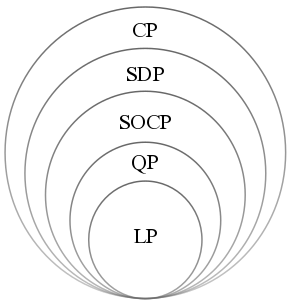|
Geometric Programming
A geometric program (GP) is an optimization problem of the form : \begin \mbox & f_0(x) \\ \mbox & f_i(x) \leq 1, \quad i=1, \ldots, m\\ & g_i(x) = 1, \quad i=1, \ldots, p, \end where f_0,\dots,f_m are posynomials and g_1,\dots,g_p are monomials. In the context of geometric programming (unlike standard mathematics), a monomial is a function from \mathbb_^n to \mathbb defined as :x \mapsto c x_1^ x_2^ \cdots x_n^ where c > 0 \ and a_i \in \mathbb . A posynomial is any sum of monomials.S. Boyd, S. J. Kim, L. Vandenberghe, and A. Hassibi. A Tutorial on Geometric Programming'' Retrieved 20 October 2019. Geometric programming is closely related to convex optimization: any GP can be made convex by means of a change of variables. GPs have numerous applications, including component sizing in IC design, aircraft design, maximum likelihood estimation for logistic regression in statistics, and parameter tuning of positive linear systems in control theory. Convex form Geometric program ... [...More Info...] [...Related Items...] OR: [Wikipedia] [Google] [Baidu] |
Optimization (mathematics)
Mathematical optimization (alternatively spelled ''optimisation'') or mathematical programming is the selection of a best element, with regard to some criteria, from some set of available alternatives. It is generally divided into two subfields: discrete optimization and continuous optimization. Optimization problems arise in all quantitative disciplines from computer science and engineering to operations research and economics, and the development of solution methods has been of interest in mathematics for centuries. In the more general approach, an optimization problem consists of maxima and minima, maximizing or minimizing a Function of a real variable, real function by systematically choosing Argument of a function, input values from within an allowed set and computing the Value (mathematics), value of the function. The generalization of optimization theory and techniques to other formulations constitutes a large area of applied mathematics. Optimization problems Opti ... [...More Info...] [...Related Items...] OR: [Wikipedia] [Google] [Baidu] |
Posynomials
A posynomial, also known as a posinomial in some literature, is a function of the form : f(x_1, x_2, \dots, x_n) = \sum_^K c_k x_1^ \cdots x_n^ where all the coordinates x_i and coefficients c_k are positive real numbers, and the exponents a_ are real numbers. Posynomials are closed under addition, multiplication, and nonnegative scaling. For example, : f(x_1, x_2, x_3) = 2.7 x_1^2x_2^x_3^ + 2x_1^x_3^ is a posynomial. Posynomials are not the same as polynomials in several independent variables. A polynomial's exponents must be non-negative integers, but its independent variables and coefficients can be arbitrary real numbers; on the other hand, a posynomial's exponents can be arbitrary real numbers, but its independent variables and coefficients must be positive real numbers. This terminology was introduced by Richard J. Duffin, Elmor L. Peterson, and Clarence Zener in their seminal book on geometric programming. Posynomials are a special case In logic, especially as a ... [...More Info...] [...Related Items...] OR: [Wikipedia] [Google] [Baidu] |
Convex Optimization
Convex optimization is a subfield of mathematical optimization that studies the problem of minimizing convex functions over convex sets (or, equivalently, maximizing concave functions over convex sets). Many classes of convex optimization problems admit polynomial-time algorithms, whereas mathematical optimization is in general NP-hard. Definition Abstract form A convex optimization problem is defined by two ingredients: * The ''objective function'', which is a real-valued convex function of ''n'' variables, f :\mathcal D \subseteq \mathbb^n \to \mathbb; * The ''feasible set'', which is a convex subset C\subseteq \mathbb^n. The goal of the problem is to find some \mathbf \in C attaining :\inf \. In general, there are three options regarding the existence of a solution: * If such a point ''x''* exists, it is referred to as an ''optimal point'' or ''solution''; the set of all optimal points is called the ''optimal set''; and the problem is called ''solvable''. * If f is unbou ... [...More Info...] [...Related Items...] OR: [Wikipedia] [Google] [Baidu] |
Integrated Circuit
An integrated circuit (IC), also known as a microchip or simply chip, is a set of electronic circuits, consisting of various electronic components (such as transistors, resistors, and capacitors) and their interconnections. These components are etched onto a small, flat piece ("chip") of semiconductor material, usually silicon. Integrated circuits are used in a wide range of electronic devices, including computers, smartphones, and televisions, to perform various functions such as processing and storing information. They have greatly impacted the field of electronics by enabling device miniaturization and enhanced functionality. Integrated circuits are orders of magnitude smaller, faster, and less expensive than those constructed of discrete components, allowing a large transistor count. The IC's mass production capability, reliability, and building-block approach to integrated circuit design have ensured the rapid adoption of standardized ICs in place of designs using discre ... [...More Info...] [...Related Items...] OR: [Wikipedia] [Google] [Baidu] |
Maximum Likelihood Estimation
In statistics, maximum likelihood estimation (MLE) is a method of estimation theory, estimating the Statistical parameter, parameters of an assumed probability distribution, given some observed data. This is achieved by Mathematical optimization, maximizing a likelihood function so that, under the assumed statistical model, the Realization (probability), observed data is most probable. The point estimate, point in the parameter space that maximizes the likelihood function is called the maximum likelihood estimate. The logic of maximum likelihood is both intuitive and flexible, and as such the method has become a dominant means of statistical inference. If the likelihood function is Differentiable function, differentiable, the derivative test for finding maxima can be applied. In some cases, the first-order conditions of the likelihood function can be solved analytically; for instance, the ordinary least squares estimator for a linear regression model maximizes the likelihood when ... [...More Info...] [...Related Items...] OR: [Wikipedia] [Google] [Baidu] |
Logistic Regression
In statistics, a logistic model (or logit model) is a statistical model that models the logit, log-odds of an event as a linear function (calculus), linear combination of one or more independent variables. In regression analysis, logistic regression (or logit regression) estimation theory, estimates the parameters of a logistic model (the coefficients in the linear or non linear combinations). In binary logistic regression there is a single binary variable, binary dependent variable, coded by an indicator variable, where the two values are labeled "0" and "1", while the independent variables can each be a binary variable (two classes, coded by an indicator variable) or a continuous variable (any real value). The corresponding probability of the value labeled "1" can vary between 0 (certainly the value "0") and 1 (certainly the value "1"), hence the labeling; the function that converts log-odds to probability is the logistic function, hence the name. The unit of measurement for the ... [...More Info...] [...Related Items...] OR: [Wikipedia] [Google] [Baidu] |
Statistics
Statistics (from German language, German: ', "description of a State (polity), state, a country") is the discipline that concerns the collection, organization, analysis, interpretation, and presentation of data. In applying statistics to a scientific, industrial, or social problem, it is conventional to begin with a statistical population or a statistical model to be studied. Populations can be diverse groups of people or objects such as "all people living in a country" or "every atom composing a crystal". Statistics deals with every aspect of data, including the planning of data collection in terms of the design of statistical survey, surveys and experimental design, experiments. When census data (comprising every member of the target population) cannot be collected, statisticians collect data by developing specific experiment designs and survey sample (statistics), samples. Representative sampling assures that inferences and conclusions can reasonably extend from the sample ... [...More Info...] [...Related Items...] OR: [Wikipedia] [Google] [Baidu] |
Linear Dynamical System
Linear dynamical systems are dynamical systems whose evolution functions are linear. While dynamical systems, in general, do not have closed-form solutions, linear dynamical systems can be solved exactly, and they have a rich set of mathematical properties. Linear systems can also be used to understand the qualitative behavior of general dynamical systems, by calculating the equilibrium points of the system and approximating it as a linear system around each such point. Introduction In a linear dynamical system, the variation of a state vector (an N-dimensional vector denoted \mathbf) equals a constant matrix (denoted \mathbf) multiplied by \mathbf. This variation can take two forms: either as a flow, in which \mathbf varies continuously with time : \frac \mathbf(t) = \mathbf \mathbf(t) or as a mapping, in which \mathbf varies in discrete steps : \mathbf_ = \mathbf \mathbf_ These equations are linear in the following sense: if \mathbf(t) and \mathbf(t) are two ... [...More Info...] [...Related Items...] OR: [Wikipedia] [Google] [Baidu] |
Control Theory
Control theory is a field of control engineering and applied mathematics that deals with the control system, control of dynamical systems in engineered processes and machines. The objective is to develop a model or algorithm governing the application of system inputs to drive the system to a desired state, while minimizing any ''delay'', ''overshoot'', or ''steady-state error'' and ensuring a level of control Stability theory, stability; often with the aim to achieve a degree of Optimal control, optimality. To do this, a controller with the requisite corrective behavior is required. This controller monitors the controlled process variable (PV), and compares it with the reference or Setpoint (control system), set point (SP). The difference between actual and desired value of the process variable, called the ''error'' signal, or SP-PV error, is applied as feedback to generate a control action to bring the controlled process variable to the same value as the set point. Other aspects ... [...More Info...] [...Related Items...] OR: [Wikipedia] [Google] [Baidu] |
LogSumExp
The LogSumExp (LSE) (also called RealSoftMax or multivariable softplus) function is a smooth maximum – a smooth approximation to the maximum function, mainly used by machine learning algorithms. It is defined as the logarithm of the sum of the exponentials of the arguments: \mathrm(x_1, \dots, x_n) = \log\left( \exp(x_1) + \cdots + \exp(x_n) \right). Properties The LogSumExp function domain is \R^n, the real coordinate space, and its codomain is \R, the real line. It is an approximation to the maximum \max_i x_i with the following bounds \max \leq \mathrm(x_1, \dots, x_n) \leq \max + \log(n). The first inequality is strict unless n = 1. The second inequality is strict unless all arguments are equal. (Proof: Let m = \max_i x_i. Then \exp(m) \leq \sum_^n \exp(x_i) \leq n \exp(m). Applying the logarithm to the inequality gives the result.) In addition, we can scale the function to make the bounds tighter. Consider the function \frac 1 t \mathrm(tx_1, \dots, tx_n). Then ... [...More Info...] [...Related Items...] OR: [Wikipedia] [Google] [Baidu] |
Affine Transformation
In Euclidean geometry, an affine transformation or affinity (from the Latin, '' affinis'', "connected with") is a geometric transformation that preserves lines and parallelism, but not necessarily Euclidean distances and angles. More generally, an affine transformation is an automorphism of an affine space (Euclidean spaces are specific affine spaces), that is, a function which maps an affine space onto itself while preserving both the dimension of any affine subspaces (meaning that it sends points to points, lines to lines, planes to planes, and so on) and the ratios of the lengths of parallel line segments. Consequently, sets of parallel affine subspaces remain parallel after an affine transformation. An affine transformation does not necessarily preserve angles between lines or distances between points, though it does preserve ratios of distances between points lying on a straight line. If is the point set of an affine space, then every affine transformation on can ... [...More Info...] [...Related Items...] OR: [Wikipedia] [Google] [Baidu] |



